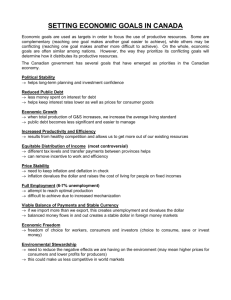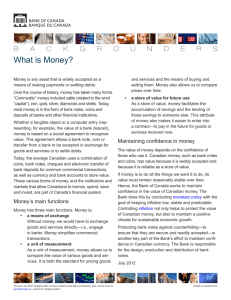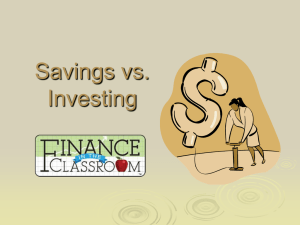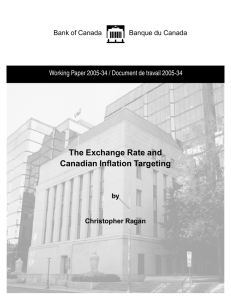IB_The Economy and You Questions (2)
advertisement
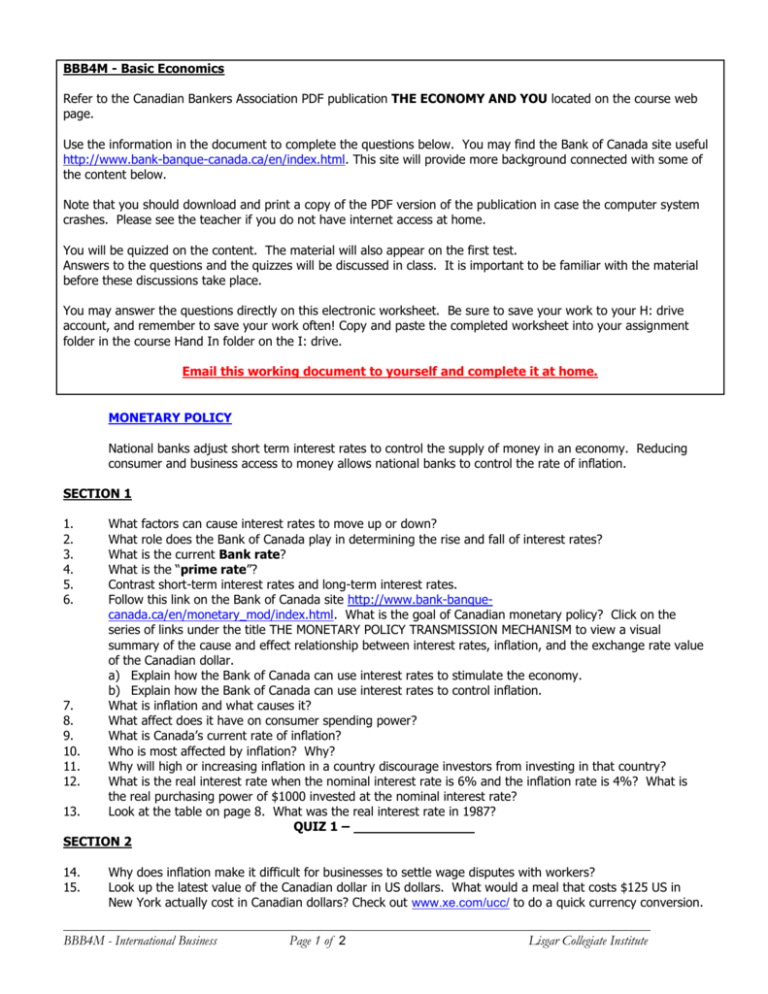
BBB4M - Basic Economics Refer to the Canadian Bankers Association PDF publication THE ECONOMY AND YOU located on the course web page. Use the information in the document to complete the questions below. You may find the Bank of Canada site useful http://www.bank-banque-canada.ca/en/index.html. This site will provide more background connected with some of the content below. Note that you should download and print a copy of the PDF version of the publication in case the computer system crashes. Please see the teacher if you do not have internet access at home. You will be quizzed on the content. The material will also appear on the first test. Answers to the questions and the quizzes will be discussed in class. It is important to be familiar with the material before these discussions take place. You may answer the questions directly on this electronic worksheet. Be sure to save your work to your H: drive account, and remember to save your work often! Copy and paste the completed worksheet into your assignment folder in the course Hand In folder on the I: drive. Email this working document to yourself and complete it at home. MONETARY POLICY National banks adjust short term interest rates to control the supply of money in an economy. Reducing consumer and business access to money allows national banks to control the rate of inflation. SECTION 1 1. 2. 3. 4. 5. 6. What factors can cause interest rates to move up or down? What role does the Bank of Canada play in determining the rise and fall of interest rates? What is the current Bank rate? What is the “prime rate”? Contrast short-term interest rates and long-term interest rates. Follow this link on the Bank of Canada site http://www.bank-banquecanada.ca/en/monetary_mod/index.html. What is the goal of Canadian monetary policy? Click on the series of links under the title THE MONETARY POLICY TRANSMISSION MECHANISM to view a visual summary of the cause and effect relationship between interest rates, inflation, and the exchange rate value of the Canadian dollar. a) Explain how the Bank of Canada can use interest rates to stimulate the economy. b) Explain how the Bank of Canada can use interest rates to control inflation. 7. What is inflation and what causes it? 8. What affect does it have on consumer spending power? 9. What is Canada’s current rate of inflation? 10. Who is most affected by inflation? Why? 11. Why will high or increasing inflation in a country discourage investors from investing in that country? 12. What is the real interest rate when the nominal interest rate is 6% and the inflation rate is 4%? What is the real purchasing power of $1000 invested at the nominal interest rate? 13. Look at the table on page 8. What was the real interest rate in 1987? QUIZ 1 – SECTION 2 14. 15. Why does inflation make it difficult for businesses to settle wage disputes with workers? Look up the latest value of the Canadian dollar in US dollars. What would a meal that costs $125 US in New York actually cost in Canadian dollars? Check out www.xe.com/ucc/ to do a quick currency conversion. BBB4M - International Business Page 1 of 2 Lisgar Collegiate Institute 16. 17. 18. 19. 20. 21. 22. 23. 24. The Canadian dollar is considered to be a commodity. What does this mean? Give two other examples of commodities. What key domestic forces impact the value of the Canadian dollar? How can the Bank of Canada boost the value of the dollar? Explain how the Asian crisis caused the American dollar to strengthen and the Canadian dollar to weaken. List the pros and cons of an increasing dollar; a decreasing dollar. What happens if too few people save money in an economy? Explain the connection between interest rates and changes in the stock market. The Bank of Canada does not operate like a regular bank. Explain. QUIZ 2 – Distinguish between country’s deficit and its debt. SECTION 3 25. 26. 27. 28. 29. 30. 31. 32. 33. 34. Why is a high level of debt bad for our economy? In 1997, did Canada have a trade deficit or a trade surplus with the United States? List the factors that can lead to an economic downturn. What is the definition of a recession? Refer to the table on p.22. Housing starts increased from 125,000 in 1996 to 147,000 in 1997. Calculate the percent change in housing starts. What other indicator in the table can best explain this upward trend in home construction? What is GDP? Use the library or the Internet to find a description for GNP. What notable differences are there between the two terms? If you were to ‘take the economy’s pulse’, what four major indicators would you watch closely? What is the Consumer Price Index? How is it used? If sales of new vehicles increase steadily, what does this suggest about the state of the economy? Why should Canadians pay close attention to U.S. economic indicators? QUIZ 3 – Also check out this site: http://www.mcwdn.org/ECONOMICS/EconMain.html for additional economics info, quizzes, links etc. BBB4M - International Business Page 1 of 2 Lisgar Collegiate Institute
